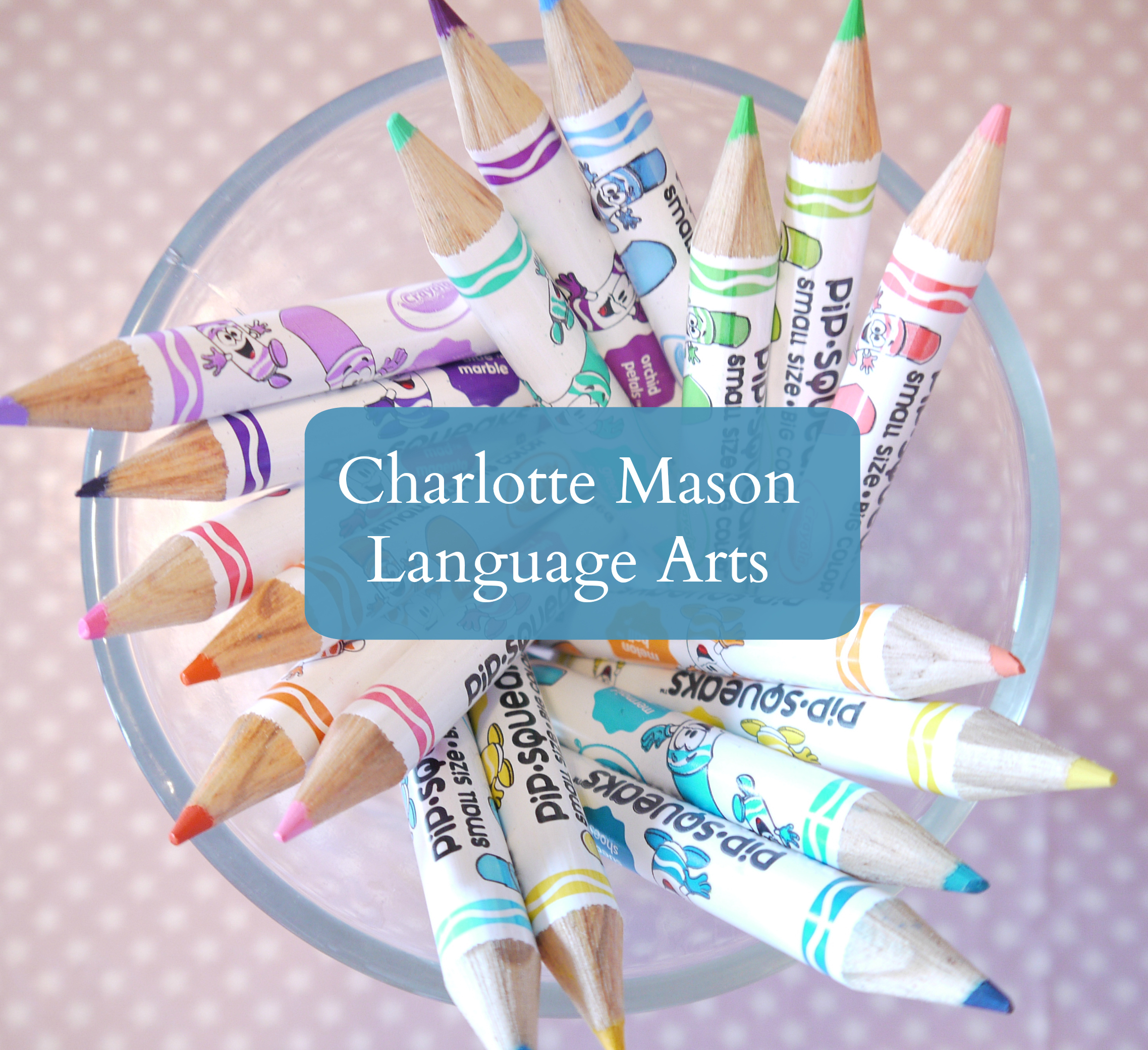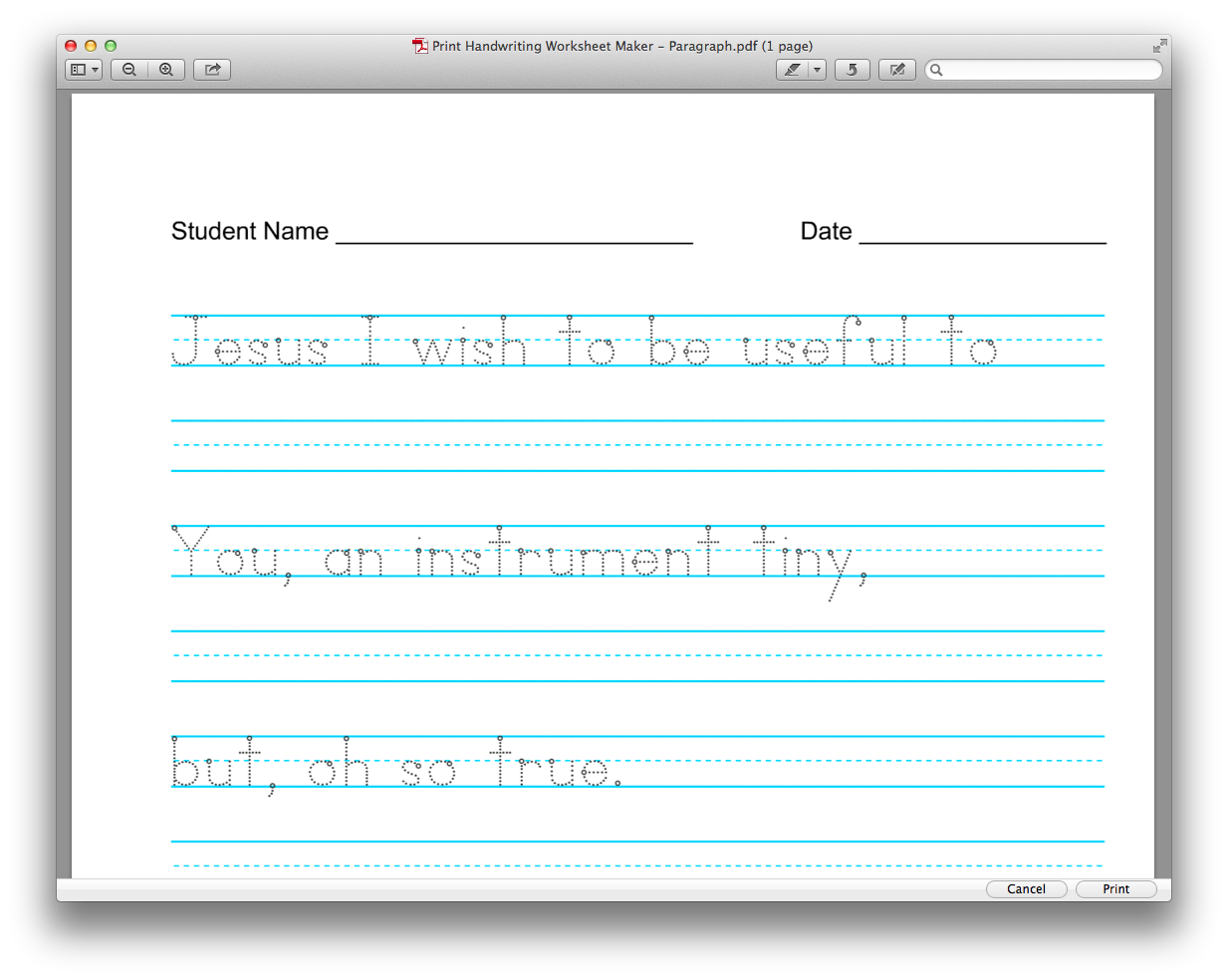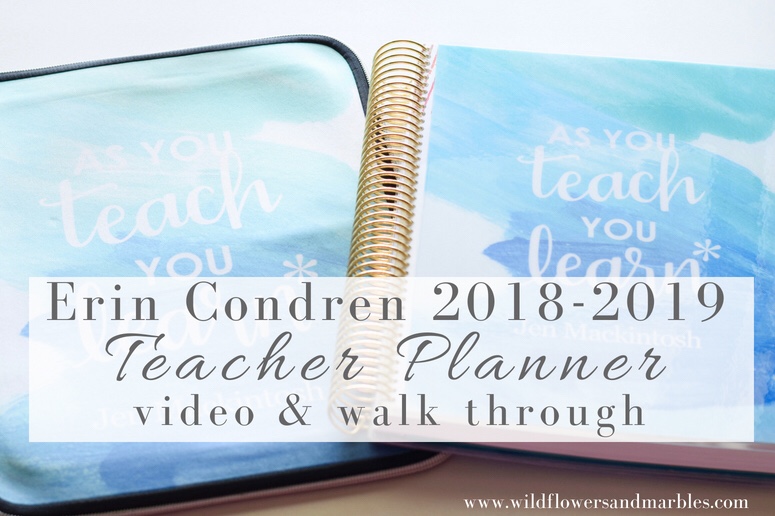Considering Language Arts – Copywork
 This discussion on copywork is part 3 in a series considering Language Arts.
This discussion on copywork is part 3 in a series considering Language Arts.Copywork is another very valuable tool in our Language Arts toolbox. At first, the name conjures up those awful writing-for-punishment assignments that used to be handed out regularly in grade school. “I will not talk in class. I will not talk in class.” But copywork is far from the meaningless written punishments from my memory.
Copywork is the copying of noble, living thoughts from poetry, literature, or from significant figures in history. The emphasis in copywork is in the perfect execution. It’s a short lesson – with younger children spending maybe 5 – 10 minutes working on forming one letter, one word at a time – perfectly!
From Charlotte Mason, Volume 1, p. 160:
“No work should be given to a child that he cannot execute perfectly, and then perfection should be required of him as a matter of course. For instance, he is set to do a copy of strokes, and is allowed to show a slateful of all sorts of slopes and all sorts of intervals; his moral sense is vitiated, his eye is injured. Set him six strokes to copy; let him, not bring a slateful, but six perfect strokes, at regular distances and at regular slopes. If he produces a faulty pair, get him to point out the fault, and persevere until he has produced his task; if he does not do it to-day, let him go on to- mrrow and the next day, and when the six perfect strokes appear, let it be an occasion of triumph.”
Copywork is another example of how language arts methods are anchored and connected to the other offerings of the day. Are you studying Isaac Newton in science? How about copying the 3 laws of motion for copywork. What is your poetry selection? Use it for copywork. Shakespeare? There are some free copywork quotes available for download here. Choose Bible verses, hymns, liturgical prayers from the Divine Office, quotes from the Saints, literary selections…as copywork choices. The point is that children are copying from beautiful living expressions and working on penmanship, punctuation, capitalization, and observing sentence structure.
- The goal is perfect execution of letters and words with short lessons so as not to frustrate or overwhelm.
- Short lessons = 5 minutes for new writers and increasing up to about 15 – 20 minutes for middle school.
- V-e-r-y—-s-l-o-w—-m-e-t-h-o-d-i-c-a-l formation of letters is my emphasis
- Each child gets a new copywork notebook at the beginning of the year. We start with a 3 ring notebook and the kids enjoy choosing special scrapbook paper to decorate their copywork notebook.
- Beginning copywork is about correct letter formation and penmanship.
- After letter formation is solidified, copywork continues to serve as penmanship practice, but I also introduce punctuation, captitalization, and other introductions to mechanics (one at a time) through copywork. I don’t flood them with information all at once, but if a copywork sentence contains a semi-colon, I discuss why it’s used.
- Selections for copywork are chosen with the same criteria used for selecting living books; writing must be of good literary quality.

Here’s where it is so important to follow your instincts and know your children!!!! Each child is different when it comes to writing skills and abilities, and my boys are different from my girls. Even with my two boys there is a dramatic difference in what each is capable of in terms of early writing. My current 5 year old is a great writer and loves it so much that the other day I caught him copying the milk carton! LOL!!! My 9 1/2 year old still struggles with writing. Early writing/copywork for him was very short, and we used alternatives for other lessons that might require writing or spelling – I often pulled out our moveable alphabet!
A Lovely Thoughts Journal – Copywork for the older child:
Up until last year, my oldest daughter (then in 8th grade) continued with and really enjoyed her copywork. Last year we focused on copywork with calligraphy using Writing Can Help, Book 4, Calligraphy and choosing from Lucy Maud Montgomery’s beautiful Victorian poetry. We then followed up with the Calligraphy Bible. Since you might be wondering about pens, I’ll let you know that she started out using the Zig calligraphy pens
, but then after some practice she was ready for a serious calligraphy pen. I still have my old Sheaffer pen, so we found some extra ink cartridges and away she went. I highly recommend the Sheaffer sets
!!
This year, my daughter doesn’t have assigned copywork on her lesson plans. She has chosen instead to continue with her calligraphy in her own commonplace book, which sounds so….common (LOL!), so we’re calling it a Lovely Thoughts Journal. She now chooses which passages she will copy, but still keeps to the same principle of perfect execution.
Many amazing literary figures kept a commonplace book to copy noble thoughts from their literature reading into their journal. I find it extraordinary that such a simple thing as copywork yields amazing and rich fruit in vocabulary and expressions, but I’m finding that it does!
A few resources that I enjoy recommending:
Though all that is really needed for copywork is a pencil and a piece of paper, I have found a few extra tools to be very helpful and enjoyed here:
- This post of mine reviews a free resource – you enter the text, the size, the font, and then print your copy work sheets. This is a great resource! Invest a little time and build a copybook for the term!
- I’m sort of picky about a smooth writing surface. I like my kids to sit at a table with room for elbows and spreading out. It’s a priority for us, but I’ve found a good workaround if table space is limited or there is a need to be portable. Dick Blick offers inexpensive large sketch clipboards (15 x 16 are $6.99 at the time of this writing) that I really like. Paper clips to the top and the surface is large enough to provide a good writing surface.
- Startwrite handwriting worksheet wizard – There are a variety of handwriting worksheet makers available for free online. I made use of these until my son was ready to transition to cursive. Free worksheet makers offering cursive don’t offer cursive letters that connect. This was the impetus that pushed me to finally purchase this program. I’m so glad I did!!!! Startwrite is my best friend when it comes to generating copywork pages for my beginning print writers or my beginning cursive writers. If you’ll allow me, I’ll sing it’s praises:
- I can enter any text from any source I choose – giving me the freedom to select copywork from history, science, religion, hymns, Baltimore Catechism – anything! I build my own copywork pages and again anchor it to the other offerings within our day so that copywork, while an exercise in penmanship, still supports other reading and is connected to the rest of the day.
- I choose the font – print, italics, cursive. I’m very pleased with the font choices and offerings!
- I choose the font size – this is a HUGE benefit to those of you that have learners with vision problems and you can’t ever seem to find a book with print large enough for penmanship practice!! Build your own in the font sizes that your children need!
- Choose from different guide lines.
- Choose stroke arrows for beginning writers to show proper letter formation. These are optional, so I can choose not show these once the letter is taught and formation is solid.
- Notebooking Pages – These are just my favorite source of printable pages! The collection of copywork pages are a favorite here – the kids enjoy choosing their pages to fill up with living sentiments, carefully copied! My daughter loves the floral designs!!! My oldest son prefers the simple designs, and my youngest son likes the alphabet copywork pages and the animal pages! These pages make fantastic copywork notebooks. My kids and I love using several of their other pages, too! The pages are very inexpensive, so you can try a set without a big investment, and there are often sales so sign up for the e-newsletter.
- Notebooking Nook -along the lines of Notebooking Pages for various subjects, but the page I’m linking you to has all of her free downloads!
- 3 ring binder and scrapbook paper to decorate the cover. This is one way we really spruce up our new coywork books at the beginning of a year!! Take a 1 inch binder
and grab some scrapbook paper
. Let each of the kids choose their own paper for their notebook covers. Now they have a pretty notebook for their copywork papers to live!
- Lined journals
for a Lovely Thoughts Journal (commonplace book). My daughter chooses her own style, but she prefers lined pages with a heavier weight paper for the calligraphy. I really like Moleskine lined notebooks
, but my daughter likes hardcover journals with pretty decorative covers.
For lots more great insight on copywork, check out the Copywork articles by Lindafay at Charlotte Mason Help. There are also wonderful articles for further reading at Ambleside Online, and my favorite source of Catholic Charlotte Mason, Mater Amabilis.
Next post in the series – Dictation!








I love the ideas of the copywork you've written on. We started using Notebook pages a year ago. My oldest (12) loves the pages for her poetry.
Now, if I can just get a handle on comma and semi colons use…I'd be a much better teacher.
I am really loving this series, Jen! When do you come out with your DVD set of instructional videos? I'd be first in line to buy!
Another wonderful post. This series is so helpful! Could you expand on the alternatives to copywork you used for your oldest son that doesn't like to write? I would appreciate it, since our oldest also doesn't like to write, though his letter formation is quite good though not perfect. Thanks!
Ladies,
Thank you so much for the kind comments! I'm so glad that this series could be of help!
Kelly asked:
>> Could you expand on the alternatives to copywork you used for your oldest son that doesn't like to write? << Sure, Kelly. First, copywork wasn't optional, but it was a short lesson and the only writing I asked for. 5 minutes a day with best effort and the goal of perfect execution. 5 minutes. Now, if we were working on building words, rather than asking him to write with a pencil, I'd use the moveable alphabet and ask him to build words with his letters. If he was copying a word that was challenging to him in terms of spelling, we'd practice building the word with the moveable alphabet and I'd ask him to make a picture of the word in his mind. Other tools were a small bin of sand or cornflour and having him trace a letter in the sand. Still another alternative is tracing letters in the air. This is super helpful for teaching letter formation with big sweeping motions with the finger rather than focusing on something tiny on a paper. Does that help illustrate that more, Kelly?
Jen,
Thank you so much. Your posts have been very helpful to me as we move towards a more Charlotte Mason day.
Thanks again for all your efforts!
Jenn
Jen, a friend of mine linked me to your blog. It is very uplifting. I love your resources, and thoughts; especially the CM homeschooling posts I read. Have you considered joining a site where you could really share such posts to encourage other like minded people? You would get your own page, and share through forums and blogging. Think about it!
http://charlottemasoneducation.ning.com/profile/PamBinns
Thanks Jen! That does help 🙂
Jen, this is wonderful! I have always wondered with my younger kids who are just finishing up printing, and taking on cursive….do you spend time SEPARATELY on the Writing Can Help books, before taking on copywork, or do you MASTER handwriting and cursive BEFORE beginning copywork? I never know if I should have them working on the WCH books with cursive while PRINTING copywork.
Hi Mary. 🙂
I used to use the Writing Can Help penmanship series for the children's penmanship, but I use copywork (assisted by Startwrite worksheets I build) for penmanship practice exclusively now.
At this point, the only time I use Writing Can Help books is for something like the calligraphy course my daughter wanted to try. She taught herself and practiced formation with the Writing Can Help book, but once she had learned her lettering formation, she simply picked back up with copywork again as normal, using her calligraphy skills.
I teach manuscript and cursive using the Startwrite program to offer guides for letter formation until the basics of letter formation is accomplished, and plug in simple copywork exercises as the actual penmanship practice. These can be very simple! For example, for my 1st grader, I'm building pages using Mother Goose rhymes (which he loves!).
If a child is just learning cursive, I might print a page from Startwrite with only one word printed in cursive…and the rest in manuscript so as not to overwhelm the new cursive writer. So…one copywork assignment –> but print or require only 1 – 2 words of cursive and the rest in print as you transition. Does this make sense? I hope so!
Since the goal of copywork is perfect execution, I'd want all their effort and energy to go into that one short lesson and for them to execute it PERFECTLY!
Hope that gives you an idea or two to use, Mary!
Jen, I am wondering about this “perfect execution” thing. How perfect is “perfect”? I am just thinking that my boys would go insane. LOL We have always done short handwriting lessons (with various children able to do more or less to qualify as “short”… I remember my oldest with fine motor problems might get one or two letters done and that was exhausting and it definitely wasn't perfect!) but I have always focused on asking the child to show me “the best” letter or word. I'll ask a child to erase and rewrite if I think he's not put his best effort forward, but… I'm not sure if the way you set up your kids is to tell them to concentrate so they can do it *well* the first time or if you tell them they're aiming for perfection or if you make them erase or what. Or maybe you have them copy the same word every day until they have it “perfectly executed”?
I guess I'm wondering what the definition of “perfect” is when you're dealing with 6 year olds?
Angela asked:
>> I guess I'm wondering what the definition of “perfect” is when you're dealing with 6 year olds? << I'm looking for 5 minutes of best effort with a goal of perfect execution. Is every letter perfect? No. Is perfect execution always our goal? Yes. I have a child with fine motor challenges, so I waited to start copywork until he was more ready for the fine motor challenge of writing. Once we began copywork, we moved very slowly and gently, and once again, lessons were super short. They still are for this child. 5 minutes and stop – before I lose him to frustration! I expect his letters to look like the letters on the page. When I say s-l-o-w–m-e-t-h-o-d-i-c-a-l writing for first lessons, I really mean super s–l–o–w. I model how to move slowly and carefully over the top of dotted letters first. Move slow enough that the pencil doesn't have a chance to jump off the guide lines. Here's another part of your question: >> I'm not sure if the way you set up your kids is to tell them to concentrate so they can do it *well* the first time or if you tell them they're aiming for perfection or if you make them erase or what. Or maybe you have them copy the same word every day until they have it “perfectly executed”? << Sorry I was unclear. Let's see…I stay with my new writers during this time to lay down good habits with writing. I don't want them to get in the habit of dawdling during the lesson. It's 5 minutes of writing. Period. Some children can write very well and write a great deal in 5 minutes. For some children (and I have one), that will be 5 minutes laboriously spent on 1 – 2 words. That's fine. It's 5 minutes of best effort. If, after 5 minutes of best effort, letters are less-than-perfect, I don't make them erase, re-write, or keep writing til perfect! It's 5 minutes of best effort. I might point out that tomorrow we're really going to move s-l-o-w-e-r so that all the letters will sit right on the line, but we're done after the short lesson. I don't want to frustrate the child. If it's clear that a letter is a particular problem for a child, I'll continue choosing copywork that includes that letter, but writing one letter over and over again has always bored and frustrated my children. They'd much prefer to write letters as part of a word and thought. So…we might trace that letter in sand, or write it really big and slow on the dry erase board if I need to model again how to form that letter, but I don't ask the child to write a page of letters or words for copywork. This isn't necessarily CM, but I have found that challenging letters are best worked out if we can write one or two really BIG on the dry erase board. Once the basic movements and formation is down, it's easier to translate that smaller on the page. Hope that helps some!
I am finding this Language Arts series very informative!
One quick question about copywork: when starting out, do you have beginning writers trace over dotted letters, or greyish letters, on lined paper, rather than them completely forming the letters on their own? Do you show them how to form each letter one at a time before beginning any copywork at all, or do you just show them as the letters come up within the words they are writing? My five year old already writes letters with no instruction from me – she just copies them from random places – and so I am trying to feel out how it will be with teaching how to form letters correctly, as she is currently forming them on her own and not necessarily in a “proper” way…
Hi Erin! Happy to answer your questions!
You asked:
>> when starting out, do you have beginning writers trace over dotted letters, or greyish letters, on lined paper, rather than them completely forming the letters on their own? << Yes. I have this option on the Startwrite sheets I build. I usually only do this once or twice, rather than pages and pages of trace and copy the letter worksheets. I demonstrate how to form the letter, and I do let my beginning writer trace. I encourage moving so slow that the traced pencil lines sit right on top of the dotted lines and you can't tell them apart. Another reason I like Startwrite is that I can build a line of dotted letters for tracing, and then leave the next line below it blank. This might be their copywork sheet for a couple of days. The first day they would need to trace slowly with the goal of perfect execution. Next, they drop down a line and write the letters/words on their own just as they traced the letters on the line above. Another question:
>> Do you show them how to form each letter one at a time before beginning any copywork at all, or do you just show them as the letters come up within the words they are writing? << I show them at the beginning of a copywork lesson. If there is a new letter or a new word, I demonstrate how to form it, moving S–L–O–W–L–Y. I like to show once on the dry erase board so I can make the letter nice and big, then again on their paper. And…
>> My five year old already writes letters with no instruction from me – she just copies them from random places – and so I am trying to feel out how it will be with teaching how to form letters correctly, as she is currently forming them on her own and not necessarily in a “proper” way… << LOL!!! Ditto here! I have a five year old doing the same thing. He's a great writer. I'm taking advantage of his enthusiasm and working with copywork. If he's making a very neat letter, but not forming it in the way that it is normally taught, I might let it go. Proper formation is really more important in cursive than print to me, because one letter has to end and be able to start another letter. So, if a child makes a print letter and ends in the wrong place…I might try to show them correct formation, and encourage a new habit, but it's not a hill I'm willing to die on. Does that make sense? If your daughter is already copying things onto paper, like my son is, now's the time to move her into some instructional copywork lessons. Make her a little notebook and work with her a little. Hope this helps!
Thank you, that is very helpful!
Is there a certain style of letters that are best to teach? Like basic block letters? I have heard great things about Handwriting without Tears, but those letters just look kind of… ugly, in my opinion, although easy to form and apparently really good for kids with fine motor issues. I learned to print a style called D'Nealian, which was a good way to ease into cursive, but I learned block lettering before that…
Never thought I'd be analyzing handwriting this much before, ha ha! I used to teach 3rd and 4th graders, who already had the basics of printing!
Erin,
I don't think there's a style that's necessarily preferred or “better than”, though there are styles that do work better for particular children. As you pointed out, the style HWT uses is particularly good for children with fine motor skill challenges. Probably the most important thing is to choose a style and stick with it and be consistent.
One of the reasons I like Startwrite so much is that I can choose from ALL of the popular font/handwriting styles to use!!!! D'Nealian is represented as is Zaner/Bloser, Getty/Dubay, and the Handwriting without Tears cursive.
Here are a few of the sample fonts offered by Startwrite:
http://www.startwrite.com/fonts.php
Hope this helps in narrowing choices down a bit!
Thanks!! Startwrite looks like a nice program!
I was reading your article on copywork and was just curious to get your opinion about the way to go about using poetry for copywork. If a poem is not punctuated “correctly” should it be copied this way or would it be better to edit the punctuation so that a beginning writer is copying correct puntuation?
Hi Anonymous!
That's a good question about poetry punctuation. In general, I leave the poetry punctuation alone, preferring to defer to the poet's original thoughts and structure. If a poem has punctuation that is somewhat egregious, I probably wouldn't ask a beginning writer/student to copy that particular poem….but I would love to use it with an older student! What fun to point out the errors and consider why the poet chose that mechanical structure!
Hi Jen,
Just revisiting these thoroughly educational and interesting blog posts.
Thank you for writing them. 🙂
A question for you:
I have some children with atrocious handwriting. We haven’t focused on perfect execution. :s I will begin to work on that immediately. However, they still should work on other writing assignments, too, should they not? Even if they still use the bad habits of poor writing they’ve gotten into? For example: in science or some other subject? What would your recommendation be?
Hi Holly!
Thanks for your kind words!
I know this is going to sound radical to you…and I promise your kids will survive! But…If it were me, I’d probably drop all other writing except for very short, very slow copywork. The reason is that it’s hard to build a good habit while still exercising the bad habit you’re trying to break – make sense? Imagine if you were trying to train a child that had a penchant for extreme exaggeration (lying) to always be truthful, but you said it was still ok to tell lies while playing with friends and at Grandma’s…how successful do you think that child would be at forming the habit of always being truthful? Not very. To work toward a good habit you’ll have to be wholehearted and willing to go SLOW, taking baby steps toward a goal, while being encouraging (not schmaltzy…just encouraging).
Do your other assignments orally if you need to. When I say short-slow, baby-stepping forward in the habit of making best effort in copywork, I’m talking about copywork that consists of ONE WORD…for the day…regardless of the age/grade of the child/children. One word. Radical, huh? But effective because it ISN’T overwhelming. You wouldn’t walk into the gym and pick up 100 lb weights right away…so don’t hand a child a paragraph or sentences and expect much in the way of progress. It’s fatiguing and the muscle memory isn’t there.
So, starting with one word, I’d model how to sit, how to hold the pencil, how to place the paper, and I’d model S-L-O-W execution of the one word. Write it big in the air first, then on paper. Snails pace slow. I would insist on “best effort” not necessarily perfect execution. If you have some remediation to do, best effort is a positive goal. Everyone, regardless of their ability, can do their best, right?!
The letters in the one word should be formed so slowly that the hand begins to learn more control, but control and muscle memory comes with time. Be patient and be consistent. Do this every day for at least 2 weeks. If you are patient enough with this approach, and give it time to build muscle memory, it WILL have an effect on overall handwriting.
After about 2-4 weeks of one-slow-best-effort-word transition to one simple sentence. And then build from there….but…the idea is that you go all the way back to the beginning with as few words and explanation as possible. Be matter of fact and kind – this is just how it is, this is what we will do so that everyone can re-learn how to do their very best writing – the end – moving forward. Once you can tell the children are working on the habit of giving their best effort of handwriting (it may not BE the VERY best they can do, but they’re working on the habit and not giving you any flack about it) then you can add back other writing assignments because now you have the same vocabulary to use in say, for example, another piece of writing (which, by the way, should be minimal for elementary age children – again…same principle…don’t flood them with busywork writing. If the child senses it’s a bunch of busywork, they begin trying to fly through just to get it done! Ask yourself if a writing assignment is truly necessary…or just a time-filler?). Anyway, let’s say you’ve determined another writing assignment to be necessary, and your child has been really working for the last month, doing their best at copying one word at a time, now you hand that child the other assignment and tell them you expect to see the same “best effort” writing that they have been giving in copywork.
I hope this is a help for you, Holly! Good luck! Radical changes are scary…but they often yield the most fruit! Go slow, be consistent, be patient – and you will see changes!
Thank you, Jen. I will attempt this.
Had a day of revisiting Simply Charlotte Mason’s all-day seminar yesterday, so I’m starting to get more confidence in following the method more wholeheartedly again.
Another question: what would you recommend about math? Their numbers are also atrocious, so those need to be a major focus as well. Does the one word a day automatically exclude math work then?
I was thinking of having them write the numbers 1-10 daily as well, but is that too much? Do I let the math (written work) slide? We’ve been working hard to get ahead since we had almost no school between October and December due to a move. I just don’t like the idea of having math work to do over the summer, or else some remaining from the same book for the new school year. Fwiw, we are doing Math-U-See.
On math, Holly, I take a hard line when it comes to handing in a paper full of numbers that are squished together and/or illegible. I give specific expectations for ALL math students: erasable pen or pencil, graph paper only to help with spacing, specific instructions on how much space should be between problems, requirement to show math work, I must be able to read numbers clearly, all answers circled. If ANY of these requirements aren’t met, I just hand the math work immediately back and require the student to rewrite the entire thing. That only happens once and then they KNOW I mean business. It’s not my job to spend/waste extra time trying to decipher illegible math. And, the student will one day have to turn in papers to professors who DEFINITELY will not spend extra time deciphering – they’ll just slap a big F on the paper and call it done.
So…I’d keep plugging away at math without slowing, explain clearly my requirements for neatness and the consequence if a student chooses to ignore my clear requirements, and if needed, post clearly and neatly written numerals 0 – 9 somewhere as a reference where all can see. (That’s all that’s needed for math, regardless of grade level.) Then, you shouldn’t get behind in math, and though it may be a little painful at first, you should see some improvement in math work.